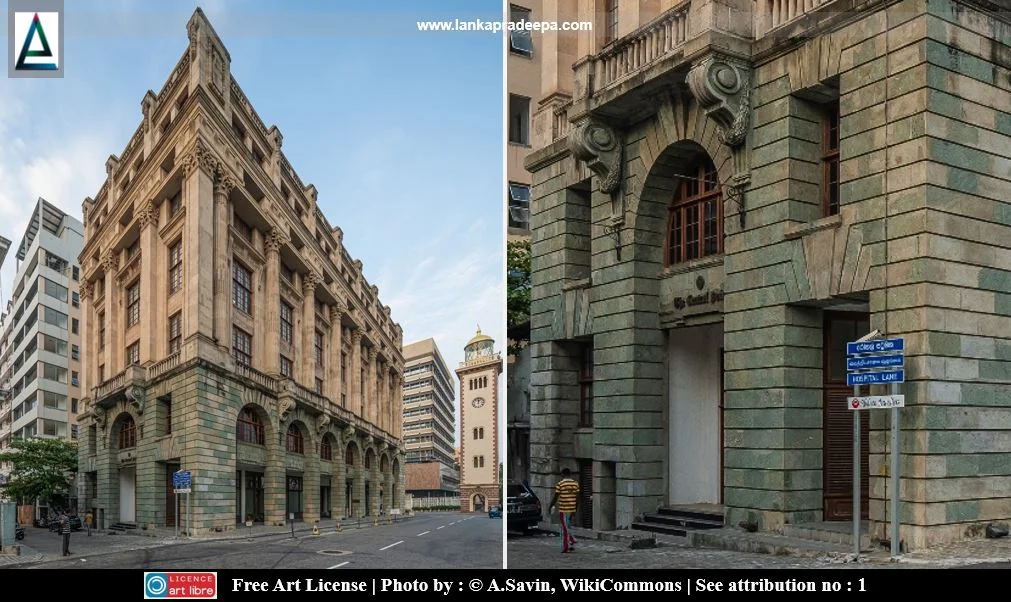
The Economic History Museum, (Sinhala: ආර්ථික ඉතිහාස කෞතුකාගාරය; Tamil: நாணய நூதனசாலை, கொழும்பு) popularly known as Currency Museum or Money Museum, is located in the old Central Point Building in Chatham Street, Colombo Fort, Sri Lanka. It is administered by the Central Bank of Sri Lanka.
History
The museum was established in 2013 by the Central Bank of Sri Lanka in The Central Point, an old building which is considered a unique example of British Colonial architecture in the Neoclassical style (Welandawe & Weerasinghe, 2016).
The Central Point Building
Designed by Walker and Adams, this five-storied building was constructed by the Ralph McDonald company by laying the foundation stone in 1911. It was completed and opened in 1914 as the branch office of the National Mutual Life Association of Australasia Ltd, an insurance company based in Australia. It was the tallest building in Colombo by 1914 and in the decade following.
In 1973, the building was acquired by the Cooperative Wholesale Establishment of Sri Lanka (CWE). In 1996, the interior of the building was damaged as a result of the bomb attack at the premises of the Central Bank by LTTE (Liberation Tigers of Tamil Eelam), a militant group designated as a terrorist organization by a number of countries including Sri Lanka, India, the USA and the EU. After that, the building remained in a dilapidated state until the Central Bank acquired it from CWE in 2011.
The Central Bank restored the building and gave it the name "The Central Point". This name was given as the building is located opposite the historic Clock Tower of Colombo which is considered the "Central Point" of the island's road network (Shantha, 2022). The distance from Colombo to any part of the island is measured starting from the foot of this clock tower.
Establishment of the museum
The Central Bank of Sri Lanka opened a museum named Central Bank Money Museum for the first time on 20 April 1982 on the ground floor of the Central Bank main building and it was inaugurated by Ronnie de Mel, Former Minister of Finance (Shantha, 2022). The museum was shifted to the Centre for Banking Studies at Rajagiriya in 1989 due to the fear of a terrorist attack by LTTE (Shantha, 2022). On 13 November 2013, the museum was moved to its current location, the Central Point Building and the name of the museum was changed from Central Bank Money Museum to Economic History Museum of Sri Lanka (Shantha, 2022).
The museum
Museum building
The five-storied museum building has been built according to British architectural traditions. The marble pillars, the staircase, the handrail and the wall lamps on the porch show the architectural uniqueness of the building. The ornamental chandelier which extends up to the fifth storey is considered one of the rarest creations (Shantha, 2022). The exterior walls of the building have been adorned with hanging pillars, arches, decorative engravings and corresponding scrolls (Shantha, 2022).
Display items
The museum presently displays a wide range of exhibits from the evolution of currency in the world, as well as its usage in Sri Lanka which is dating from the 3rd century B.C. to the present. Coins used during various periods of the country such as the Anuradhapura, Polonnaruwa, Dambadeniya, Kotte and Kandy kingdoms, and during the colonial rule of the country and notes and coins issued by the Central Bank of Sri Lanka are displayed in the museum. Self-learning tools to detect the security features of currency notes, and videos on currency are also available.
The museum has three main exhibition zones (Shantha, 2022);
#) Zone No. 1: depicts special milestones of old currency and related history of trade and commerce.
#) Zone No. 2: exhibits the series of coins and notes, commemorative coins and notes issued after the establishment of the Central Bank and related information.
#) Zone No. 3: describes the coinage, the process of printing banknotes as well as the security features of the notes.
Attribution
1) SL Colombo asv2020-01 img26 Currency Museum by A.Savin is under the Free Art License 1.3References
1) Shantha, R.D.A., 2022. Museum Guide; Sri Lanka Economic History Museum. Central Bank of Sri Lanka. ISBN: 978-624-5917-23-5. pp.6,11-12,14.
2) Welandawe, H., Weerasinghe, J., 2016. Urban Heritage in the Western Region Megapolis Planning Project. p.13.
Location Map
This page was last updated on 14 January 2023


